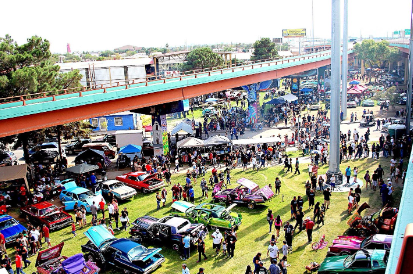By Eric Morales
If you travel west on Interstate-10 in El Paso, Texas, you will see numerous businesses, malls, restaurants, and other attractions. However, there is a certain place that is overlooked by many travelers. This spot has numerous freeway ramps intersecting with one other that the locals in El Paso call the "Spaghetti Bowl." Although this location was not initially covered by freeways, it was home to a community of neighborhoods of African Americans and Mexican Americans known as the Concordia community. Today, this place is known as Lincoln Park, also known as El Paso's Chicano Park, or "El Corazón de El Paso."
Lincoln Park is a standing historical landmark, unfortunately, some do not consider it to be one. In 2011, the Texas Department of Transportation requested to demolish this structure. This park was the site of the first Mexican community north of the Rio Grande. The Lincoln community became a neighborhood in the early twentieth century in El Paso's East Side at the city limits.1 One historical figure who had a great impact on the community was Hugh Stephenson, who built a home in this area, and established a cemetery famously known as the oldest cemetery in El Paso, the Concordia Cemetery. A church named San Jose de Concordia el Alto was also founded by Ramon Ortiz.
The Lincoln community has seen various changes within society, but one structure still stands underneath the horrible damage from the freeways. Lincoln School, formerly known as Concordia School, opened as a one-room school in 1868. In 1880, the school then expanded to a four-room adobe building. The Lincoln Park neighborhood emerged as an idyllic but conflicted community with dramatic changes to unfold with the creation of El Paso's freeways in the 1960s.2 In 1970, the El Calvario Church, established in 1933, was demolished to make way for a column needed to hold the section of the freeway being created, which would lead into the Bridge of Americas Port of Entry.
In 1973, the city of El Paso requested to use the open space beneath Interstate-10 for public purposes, thus creating Lincoln Park. Nestor Valencia was the individual who designed the park. Despite all the conflict that affected several people that lived in the Lincoln community, and the historical construct this location holds, in 1983, Bobby Adauto, the Lincoln Park director, asked Felipe Adame, a Chicano artist, to paint murals on the freeway pillars. This plan would continue for a number of years, allowing other muralists to paint the history of the Lincoln community and their pride for El Paso, which inspired a mural to be painted named "El Corazón de El Paso," hence giving the park its nickname.
This park became an ideal location for locals to organize events and spend time on this historic ground that sustained severe loss to its historical community. Next time you are on Interstate-10 driving west, look to your left. Once you pass through the "Spaghetti Bowl," watch the history and the murals come to life telling the stories and histories of the Concordia community.
First Image: One mural resembling the heart and pride of the City of El Paso.
Second Image: A mural next to what was formerly Lincoln School (Concordia School).
Third Image: More murals under Interstate-10.
Fourth Image: An event at Lincoln Park.
Footnotes:
1 Juárez, Miguel. “From Buffalo Soldiers to Redlined Communities: African American Community Building in El Paso’s Lincoln Park Neighborhood.”
2 Juárez, Miguel. “From Buffalo Soldiers to Redlined Communities: African American Community Building in El Paso’s Lincoln Park Neighborhood.”
References:
Lincoln Park Conservation Committee. “History.” Accessed April 13, 2023. http://lincolnparkcc.org/history/.
Juárez, Miguel. “From Buffalo Soldiers to Redlined Communities: African American Community Building in El Paso’s Lincoln Park Neighborhood.” American studies (Lawrence) 58, no. 3 (2019): 107–124








Commentaires